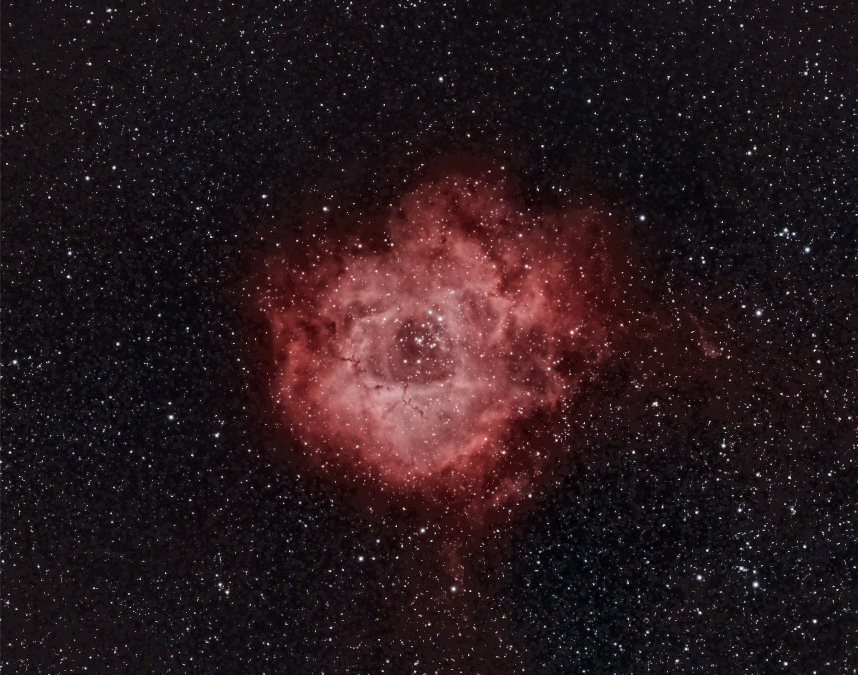It was the end of the night really, and as the Earth rotated, my real target had moved behind the neighboring apartment, but the night was still dark (well, as dark as it gets is Brooklyn, which is not very), so I pointed to the Rosette as a good target for imaging with the narrowband filter from the city. This is only 125 minutes of data, but still not bad.
What I’ve come to realize in only the past year or two is just how dusty the sky is. I mean, on an absolute scale, space is till vacuum and not much there. But the “inky black” of space isn’t quite true. Ignore things like atmospheric sky glow, there’s simply a lot of that thin, hazy dust scattered between the stars, some of which catches a bit of star light so the background is never truly black. What looks like a mottled, incompletely removed background noise is often really just underexposed dust clouds. At f/5 with the narrowband filters, that’s not going to show up except for weak bits that are glowing hydrogen. Imaging this without the filter from a truly dark sight would be interesting.

| Object | NGC 2238, Rosette Nebular, HII Region in Monoceros |
| Camera | ASI2600MC, APS-C CMOS color camera |
| Lens/Scope | William Optics RedCat 51 |
| Exposure | 25 x 300 sec, OPT TRIAD Ultra Quad-band filter |
| Location | Bay Ridge, Brooklyn, NY |
| Processing | PixInsight: started with NormalizedScaledGradient, as explained by Adam Block |
Written by Roland Roberts
Search
.Archives
- May 2025 (1)
- October 2024 (1)
- May 2024 (2)
- April 2024 (3)
- September 2022 (5)
- April 2022 (1)
- January 2022 (3)
- December 2021 (4)
- September 2021 (3)
- July 2021 (1)
- January 2021 (1)
- November 2020 (2)
- October 2020 (2)
- September 2020 (2)
- August 2020 (5)
- July 2020 (1)
- November 2019 (2)
- September 2019 (1)
- August 2019 (2)
- September 2017 (1)
- August 2017 (1)
- September 2015 (3)
- August 2015 (2)
- June 2015 (5)
- May 2015 (3)
- May 2013 (2)
- January 2013 (1)
- December 2012 (2)
- September 2012 (1)
- June 2012 (1)
- May 2012 (1)
- October 2011 (2)
- September 2011 (2)
- April 2011 (2)
- March 2011 (10)
- January 2011 (8)
- November 2010 (2)
- October 2010 (1)
- September 2010 (3)
- August 2010 (2)
- July 2010 (1)
- June 2010 (1)
- April 2010 (3)
- February 2010 (3)
- January 2010 (3)
- December 2009 (6)
- November 2009 (3)
- October 2009 (7)
- September 2009 (8)
- August 2009 (4)
- July 2009 (1)
- June 2009 (2)
- May 2009 (2)
- April 2009 (7)
- March 2009 (1)
- February 2009 (6)
- January 2009 (4)
- December 2008 (4)
- November 2008 (3)
- October 2008 (11)
- September 2008 (4)
- August 2008 (5)
- July 2008 (5)
- June 2008 (2)
- April 2008 (4)
- March 2008 (18)
- February 2008 (9)
- November 2007 (1)
- October 2007 (3)
- July 2007 (3)
- April 2007 (1)
- March 2007 (6)
- February 2007 (3)
- December 2006 (3)
- October 2006 (4)
- September 2006 (1)
- July 2006 (5)
- May 2006 (10)
- April 2006 (9)
